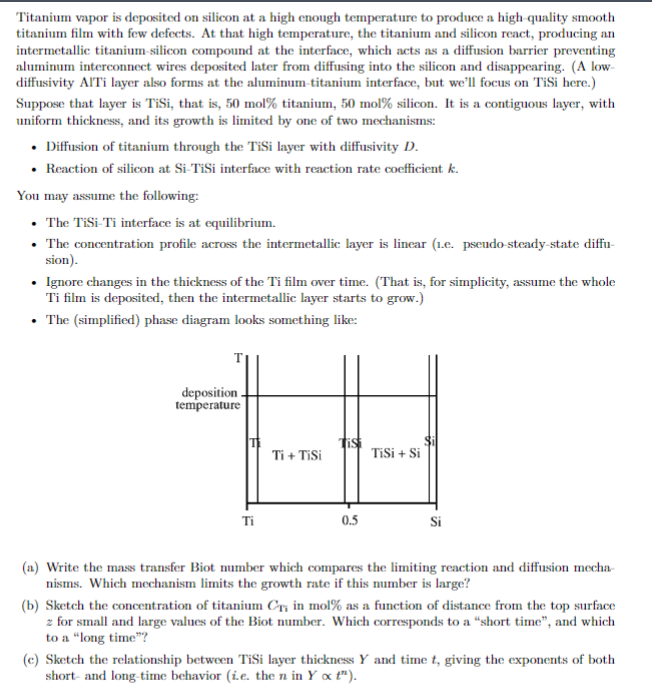Answered step by step
Verified Expert Solution
Question
1 Approved Answer
Titanium vapor is deposited on silicon at a high enough temperature to produce a high - quality smooth titanium film with few defects. At that
Titanium vapor is deposited on silicon at a high enough temperature to produce a highquality smooth
titanium film with few defects. At that high temperature, the titanium and silicon react, producing an
intermetallic titaniumsilicon compound at the interface, which acts as a diffusion barrier preventing
aluminum interconnect wires deposited later from diffusing into the silicon and disappearing. A low
diffusivity AITi layer also forms at the aluminumtitanium interface, but we'll focus on TiSi here.
Suppose that layer is TiSi, that ismol titanium, mol silicon. It is a contiguous layer, with
uniform thickness, and its growth is limited by one of two mechanisms:
Diffusion of titanium through the TiSi layer with diffusivity
Reaction of silicon at TiSi interface with reaction rate coefficient
You may assume the following:
The TiSiTi interface is at equilibrium.
The concentration profile across the intermetallic layer is linear e pseudosteadystate diffu
sion
Ignore changes in the thickness of the Ti film over time. That is for simplicity, assume the whole
Ti film is deposited, then the intermetallic layer starts to grow.
The simplified phase diagram looks something like:
a Write the mass transfer Biot number which compares the limiting reaction and diffusion mecha
nisms. Which mechanism limits the growth rate if this number is large?
b Sketch the concentration of titanium in mol as a function of distance from the top surface
for small and large values of the Biot number. Which corresponds to a "short time", and which
to a "long time"?
c Sketch the relationship between TiSi layer thickness and time giving the exponents of both
short and longtime behavior ie the in

Step by Step Solution
There are 3 Steps involved in it
Step: 1

Get Instant Access to Expert-Tailored Solutions
See step-by-step solutions with expert insights and AI powered tools for academic success
Step: 2

Step: 3

Ace Your Homework with AI
Get the answers you need in no time with our AI-driven, step-by-step assistance
Get Started


